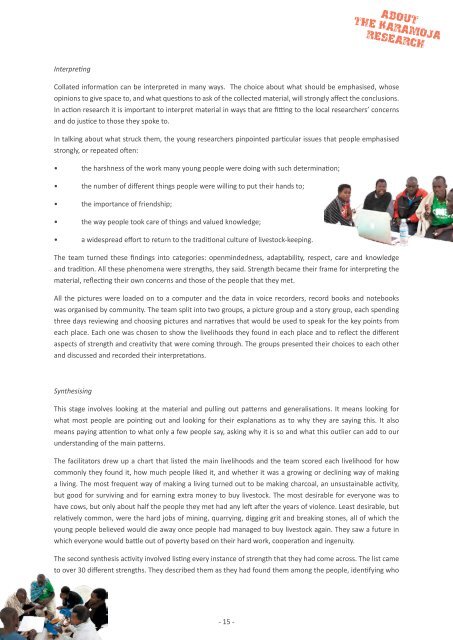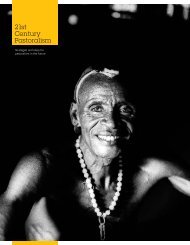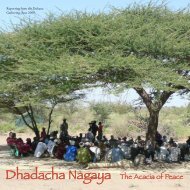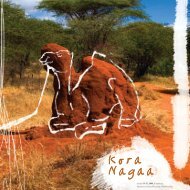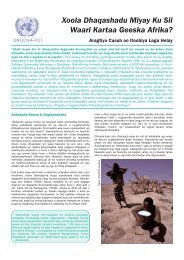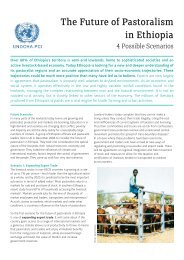Download PDF (1.47Mb) - the Website of the Pastoralist ...
Download PDF (1.47Mb) - the Website of the Pastoralist ...
Download PDF (1.47Mb) - the Website of the Pastoralist ...
You also want an ePaper? Increase the reach of your titles
YUMPU automatically turns print PDFs into web optimized ePapers that Google loves.
ABOUT<br />
THE KARAMOJA<br />
RESEARCH<br />
Interpreting<br />
Collated information can be interpreted in many ways. The choice about what should be emphasised, whose<br />
opinions to give space to, and what questions to ask <strong>of</strong> <strong>the</strong> collected material, will strongly affect <strong>the</strong> conclusions.<br />
In action research it is important to interpret material in ways that are fitting to <strong>the</strong> local researchers’ concerns<br />
and do justice to those <strong>the</strong>y spoke to.<br />
In talking about what struck <strong>the</strong>m, <strong>the</strong> young researchers pinpointed particular issues that people emphasised<br />
strongly, or repeated <strong>of</strong>ten:<br />
• <strong>the</strong> harshness <strong>of</strong> <strong>the</strong> work many young people were doing with such determination;<br />
• <strong>the</strong> number <strong>of</strong> different things people were willing to put <strong>the</strong>ir hands to;<br />
• <strong>the</strong> importance <strong>of</strong> friendship;<br />
• <strong>the</strong> way people took care <strong>of</strong> things and valued knowledge;<br />
• a widespread effort to return to <strong>the</strong> traditional culture <strong>of</strong> livestock-keeping.<br />
The team turned <strong>the</strong>se findings into categories: openmindedness, adaptability, respect, care and knowledge<br />
and tradition. All <strong>the</strong>se phenomena were strengths, <strong>the</strong>y said. Strength became <strong>the</strong>ir frame for interpreting <strong>the</strong><br />
material, reflecting <strong>the</strong>ir own concerns and those <strong>of</strong> <strong>the</strong> people that <strong>the</strong>y met.<br />
All <strong>the</strong> pictures were loaded on to a computer and <strong>the</strong> data in voice recorders, record books and notebooks<br />
was organised by community. The team split into two groups, a picture group and a story group, each spending<br />
three days reviewing and choosing pictures and narratives that would be used to speak for <strong>the</strong> key points from<br />
each place. Each one was chosen to show <strong>the</strong> livelihoods <strong>the</strong>y found in each place and to reflect <strong>the</strong> different<br />
aspects <strong>of</strong> strength and creativity that were coming through. The groups presented <strong>the</strong>ir choices to each o<strong>the</strong>r<br />
and discussed and recorded <strong>the</strong>ir interpretations.<br />
Syn<strong>the</strong>sising<br />
This stage involves looking at <strong>the</strong> material and pulling out patterns and generalisations. It means looking for<br />
what most people are pointing out and looking for <strong>the</strong>ir explanations as to why <strong>the</strong>y are saying this. It also<br />
means paying attention to what only a few people say, asking why it is so and what this outlier can add to our<br />
understanding <strong>of</strong> <strong>the</strong> main patterns.<br />
The facilitators drew up a chart that listed <strong>the</strong> main livelihoods and <strong>the</strong> team scored each livelihood for how<br />
commonly <strong>the</strong>y found it, how much people liked it, and whe<strong>the</strong>r it was a growing or declining way <strong>of</strong> making<br />
a living. The most frequent way <strong>of</strong> making a living turned out to be making charcoal, an unsustainable activity,<br />
but good for surviving and for earning extra money to buy livestock. The most desirable for everyone was to<br />
have cows, but only about half <strong>the</strong> people <strong>the</strong>y met had any left after <strong>the</strong> years <strong>of</strong> violence. Least desirable, but<br />
relatively common, were <strong>the</strong> hard jobs <strong>of</strong> mining, quarrying, digging grit and breaking stones, all <strong>of</strong> which <strong>the</strong><br />
young people believed would die away once people had managed to buy livestock again. They saw a future in<br />
which everyone would battle out <strong>of</strong> poverty based on <strong>the</strong>ir hard work, cooperation and ingenuity.<br />
The second syn<strong>the</strong>sis activity involved listing every instance <strong>of</strong> strength that <strong>the</strong>y had come across. The list came<br />
to over 30 different strengths. They described <strong>the</strong>m as <strong>the</strong>y had found <strong>the</strong>m among <strong>the</strong> people, identifying who<br />
- 15 -


